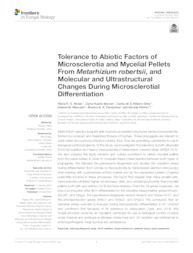Tolerance to abiotic factors of microsclerotia and mycelial pellets from Metarhizium robertsii, and molecular and ultrastructural changes during microsclerotial differentiation.
Tolerance to abiotic factors of microsclerotia and mycelial pellets from Metarhizium robertsii, and molecular and ultrastructural changes during microsclerotial differentiation.
Autoria: PAIXÃO, F. R. S. da; HUARTE BONNET, C.; RIBEIRO-SILVA, C. de S.; MASCARIN, G. M.; FERNANDES, E. K. K.; PEDRINI, N.
Resumo: Abstract: Metarhizium species fungi are able to produce resistant structures termed microsclerotia, formed by compact and melanized threads of hyphae. These propagules are tolerant to desiccation and produce infective conidia; thus, they are promising candidates to use in biological control programs. In this study, we investigated the tolerance to both ultraviolet B (UV-B) radiation and heat of microsclerotia of Metarhizium robertsii strain ARSEF 2575. We also adapted the liquid medium and culture conditions to obtain mycelial pellets from the same isolate in order to compare these characteristics between both types of propagules. We followed the peroxisome biogenesis and studied the oxidative stress during differentiation from conidia to microsclerotia by transmission electron microscopy after staining with a peroxidase activity marker and by the expression pattern of genes potentially involved in these processes. We found that despite their twice smaller size, microsclerotia exhibited higher dry biomass, yield, and conidial productivity than mycelial pellets, both with and without UV-B and heat stresses. From the 16 genes measured, we found an induction after 96-h differentiation in the oxidative stress marker genes MrcatA, MrcatP, and Mrgpx; the peroxisome biogenesis factors Mrpex5 and Mrpex14/17; and the photoprotection genes Mrlac1 and Mrlac2; and Mrlac3. We concluded that an oxidative stress scenario is induced during microsclerotia differentiation in M. robertsii and confirmed that because of its tolerance to desiccation, heat, and UV-B, this fungal structure could be an excellent candidate for use in biological control of pests under tropical and subtropical climates where heat and UV radiation are detrimental to entomopathogenic fungi survival and persistence.
Ano de publicação: 2021
Tipo de publicação: Artigo de periódico
Unidade: Embrapa Meio Ambiente
Observações
1 - Por padrão são exibidas publicações dos últimos 20 anos. Para encontrar publicações mais antigas, configure o filtro ano de publicação, colocando o ano a partir do qual você deseja encontrar publicações. O filtro está na coluna da esquerda na busca acima.
2 - Para ler algumas publicações da Embrapa (apenas as que estão em formato ePub), é necessário ter, no celular ou computador, um desses softwares gratuitos. Sistemas Android: Google Play Livros; IOS: iBooks; Windows e Linux: software Calibre.
Acesse outras publicações
Acesse a Base de Dados da Pesquisa Agropecuária (BDPA) para consultar o acervo completo das bibliotecas da Embrapa.

